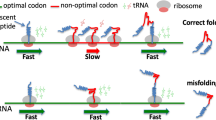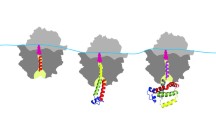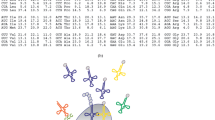Abstract
More than 31,000 protein-coding sequences (CCDS) have been identified in the human genome. Here, we analyzed codon usage in all human CCDS and found that there is a preferential usage of minor codons for Ala (CGC), Pro (CCG), Ser (UCG), and Thr (ACG) in the initial 50-codon sequences of the CCDS. These codons, with consensus XCG sequences, are most infrequently used among their synonymous codons. Thus, the tRNA concentrations per codon are considered to be highest for the minor codons for Ala, Pro, Ser and Thr in comparison with other synonymous codons for each of them to enhance the translation efficiency. This suggests that human genes are regulated at the level of translation by preferentially using minor codons within the first 50 codons of the CCDS. This hypothesis was experimentally confirmed by comparing the expression of the luciferase gene encoded by minor codons with that encoded by major codons.




Similar content being viewed by others
References
Alam J, Cook JL (1990) Reporter genes: application to the study of mammalian gene transcription. Anal Biochem 188:245–254
Chen GT, Inouye M (1994) Role of the AGA/AGG codons, the rarest codons in global gene expression in Escherichia coli. Genes Dev 8:2641–2652
Crick FH (1968) The origin of the genetic code. J Mol Biol 38:367–379
Dittmar KA, Goodenbour JM, Pan T (2006) Tissue-specific differences in human transfer RNA expression. PLoS Genet 2:e221. doi:10.1371/journal.pgen.0020221
Goldman E (2011) tRNA and the human genome. Wiley Online Library
Ikemura T (1981) Correlation between the abundance of Escherichia coli transfer RNAs and the occurrence of the respective codons in its protein genes: a proposal for a synonymous codon choice that is optimal for the E. coli translational system. J Mol Biol 151:389–409
Nedialkova DD, Leidel SA (2015) Optimization of codon translation rates via tRNA modifications maintains proteome integrity. Cell 161:1606–1618. doi:10.1016/j.cell.2015.05.022
Novoa EM, Ribas de Pouplana L (2012) Speeding with control: codon usage, tRNAs, and ribosomes. Trends Genet 28:574–581. doi:10.1016/j.tig.2012.07.006
Plotkin JB, Kudla G (2011) Synonymous but not the same: the causes and consequences of codon bias. Nat Rev Genet 12:32–42. doi:10.1038/nrg2899
Pruitt KD, Harrow J, Harte RA, Wallin C, Diekhans M, Maglott DR, Searle S, Farrell CM, Loveland JE, Ruef BJ, Hart E, Suner MM, Landrum MJ, Aken B, Ayling S, Baertsch R, Fernandez-Banet J, Cherry JL, Curwen V, Dicuccio M, Kellis M, Lee J, Lin MF, Schuster M, Shkeda A, Amid C, Brown G, Dukhanina O, Frankish A, Hart J, Maidak BL, Mudge J, Murphy MR, Murphy T, Rajan J, Rajput B, Riddick LD, Snow C, Steward C, Webb D, Weber JA, Wilming L, Wu W, Birney E, Haussler D, Hubbard T, Ostell J, Durbin R, Lipman D (2009) The consensus coding sequence (CCDS) project: identifying a common protein-coding gene set for the human and mouse genomes. Genome Res 19:1316–1323. doi:10.1101/gr.080531.108
Qian W, Yang JR, Pearson NM, Maclean C, Zhang J (2012) Balanced codon usage optimizes eukaryotic translational efficiency. PLoS Genet 8:e1002603. doi:10.1371/journal.pgen.1002603
Quax TE, Claassens NJ, Soll D, van der Oost J (2015) Codon bias as a means to fine-tune gene expression. Mol Cell 59:149–161. doi:10.1016/j.molcel.2015.05.035
Tuller T, Zur H (2015) Multiple roles of the coding sequence 5′ end in gene expression regulation. Nucleic Acids Res 43:13–28. doi:10.1093/nar/gku1313
Acknowledgments
We thank Dr. S. Brill for the critical reading of this manuscript. This work was supported by grants from the KRIBB Research Initiative Program.
Author information
Authors and Affiliations
Corresponding authors
Electronic supplementary material
Below is the link to the electronic supplementary material.
Rights and permissions
About this article
Cite this article
Park, JH., Kwon, M., Yamaguchi, Y. et al. Preferential use of minor codons in the translation initiation region of human genes. Hum Genet 136, 67–74 (2017). https://doi.org/10.1007/s00439-016-1735-x
Received:
Accepted:
Published:
Issue Date:
DOI: https://doi.org/10.1007/s00439-016-1735-x




